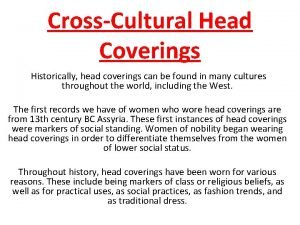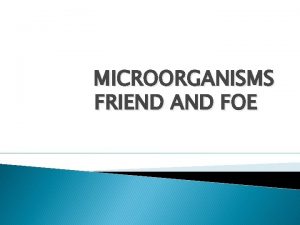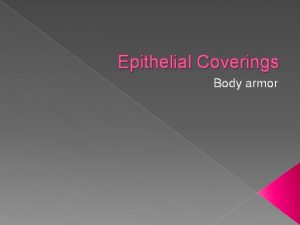Surgical Head Coverings Microorganisms that lead to surgical










- Slides: 10

Surgical Head Coverings

Microorganisms that lead to surgical site infections (SSIs) may either be present on the patient’s skin or mucous membranes or transmitted to the patient by health care personnel, the environment, or other items in the perioperative setting. While there is not presently conclusive evidence that wearing a head covering and mask impact the prevention of SSIs, the possible patient benefits compared with the risks suggest that all members of the perioperative team should cover their heads, hair, and ears in the semi-restricted and restricted areas to offer the best possible protection.

AORN Guidelines “Personnel entering the semi-restricted and restricted areas should cover the head, hair, ears, and facial hair. ” (p 121)) Intervention III. a. further states: “A clean surgical head cover or hood that confines all hair and completely covers the ears, scalp skin, sideburns, and nape of the neck should be worn. ” (p 121))

Airborne Contamination and Bacterial Shedding Both the human body and the items within the operating room are possible sources of microbial contamination and transmission. Reducing the patient’s exposer to microorganisms shed from the hair and body of surgical staff may decrease the risk of a patient developing a SSI. Humans shed up to 10 million particles from their skin every day and approximately 10% of the shed skin squames carry viable microorganisms. 1, 000 skin scales per minute are released during the natural act of walking

Organisms in the Hair In conducted studies the most common pathogen found was S aureus, which was found more often in the individuals hair than their nares The presence of Escherichia coli and Streptococcus viridans was also noted

Head Covering and Bacterial Count While there is mixed evidence, Mc. Hugh et al noted that wearing surgical head coverings decreased bacterial contamination of the surgical field, however. Even though there is mixed evidence, researchers do continue to recommend the complete covering of hair while in the operating room setting.

Ear Covering and Bacterial Count An experiment conducted by Owers et al in which surgical staff members had their foreheads, eyebrows and ears swabbed, resulted in a greater number of bacterial colonies cultured from the individuals ears.

Agencies That Support Full Head Coverings AORN Centers World for Medicare and Medicaid Health Organization Association Centers of Surgical Technologists for Disease Control

Re-Cap There currently is clear evidence that human begins are colonized with bacteria, that microorganisms are continuously shed into the air, and that airborne microorganisms can result in SSIs. Hair contains pathogenic bacteria and microorganisms that have been identified to cause SSIs. Based on current literature and reviewed evidence, covering the hair and ears in the surgical settings is a practical act to decrease the risk of harming a patient. While there is no definitive evidence that covering hair prevents SSIs, current literature shows an increased risk to patients when exposed to the skin and hair of perioperative staff, and case studies have established a connection between exposure and SSIs.

REFERENCES Guideline for surgical attire. in: Guidelines for Perioperative Practice. AORN, Inc, Denver, CO; 2017: 105– 128 Mc. Hugh, S. M. , Corrigan, M. A. , Hill, A. D. K. , and Humphreys, H. Surgical attire, practices and their perception in the prevention of surgical site infection. Surgeon. 2014; 12: 47– 52 Noble, W. C. Dispersal of skin microorganisms. Br J Dermatol. 1975; 93: 477– 485 Owers, K. L. , James, E. , and Bannister, G. C. Source of bacterial shedding in laminar flow theatres. J Hosp Infect. 2004; 58: 230– 232 Sciple, G. W. , Riemensnider, D. K. , and Schleyer, C. A. J. Recovery of microorganisms shed by humans into a sterilized environment. Appl Environ Microbiol. 1967; 15: 1388– 1392



















